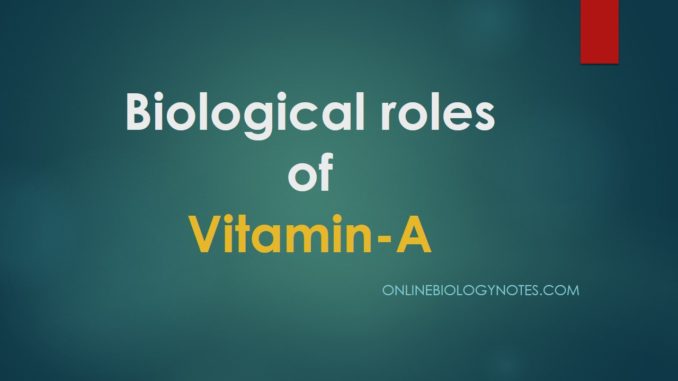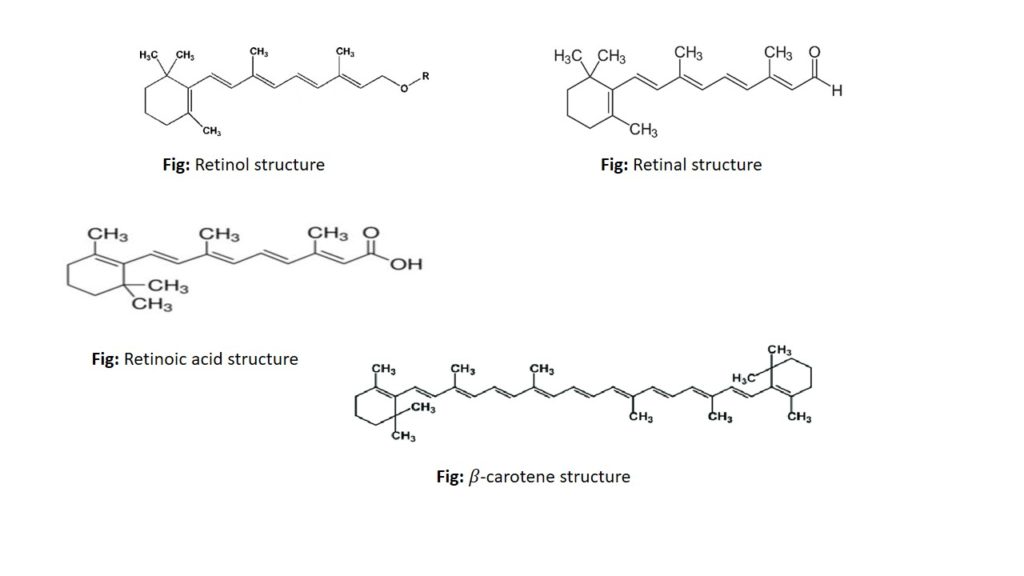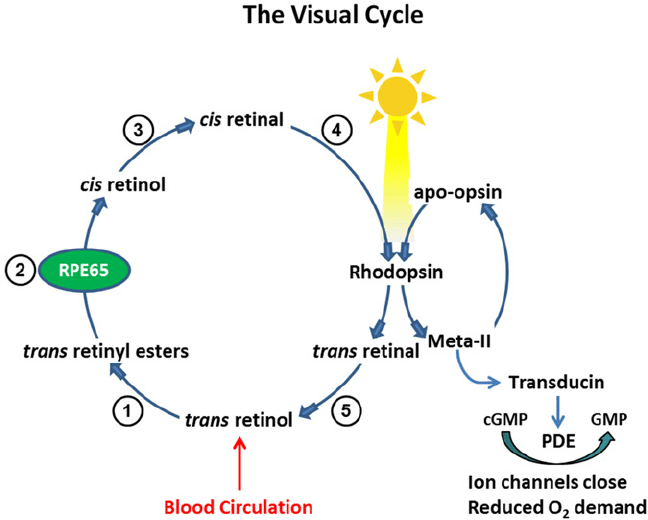
- Vitamin A comprises of a group of compounds collectively called retinoids which includes retinal, retinol, retinoic acid and a pro-vitamin A obtained from plant source (
β-carotene).
- These are required for vision, growth, reproduction, and normal maintenance of epithelial cells.
- Vitamin A is obtained only from foods of animal source.
- Plant source can only provide pro-vitamin A (
β-carotene).
β-carotene is only 1/6th as efficient as retinol.
Structure of Vitamin A derivatives:

Properties of Vitamin A:
- Retinol is a viscid, colorless oil.
- Retinol is a steroid hormone which helps in cell growth and differentiation.
- However, by careful fractionation it has also been isolated as pale yellowish needles.
- It gives a characteristic absorption band in Ultraviolet spectrum at 328 m
.
- It is fat soluble but insoluble in water.
- Loss of vitamin A occurs while cooking, canning and freezing is less, however, oxidizing agents destroy it.
- It is destroyed on exposure to UV light.
- Retinol is stored as retinyl ester in animal tissues.
Biological role of vitamin-A:
- Vitamin-A is essential for vision, growth and reproduction and to maintain normal epithelial cells.
- Role of vitamin A in vision: Vitamin A regulates visual cycle (Wald’s visual cycle):
- Both dark, bright and color vision depends upon the activity of vitamin A.
- Rods are responsible for dim light vision, where as cones are responsible for color and bright light vision.

- Dark adaptation time:
- In the absence of vit-A the dark adaptation time is longer.
- When an individual suddenly enter the dim light room rhodopsin are depleted.
- The room appears dark until and unless rhodopsin is not regenerated.
- For this reason, vit-A is required.
- Color vision:
- Cones are responsible for color vision such as Iodopsin (green), cyanopsin (blue) and porphyropsin (red).
- These also form retinal complexes and upon bleaching release different colors, red, blue, and green which are transmitted as nerve impulse to central nervous system.
2. Maintenance of healthy epithelial surfaces:
- Retinol and retinoic acid regulate/control the keratin gene and therefore prevent the formation of keratinized (horny) surfaces.
- Similarly, retinyl-phosphate are involved in the synthesis of mucus (mucopolysaccharide) as well as glycoprotein, which is required to keep the epithelial surfaces smooth and moist.
3. Cell growth and differentiation:
- Retinol and retinoic acid behave like a steroid hormone which is regulated for growth and differentiation of cells.
4. Lipid metabolism:
- Mevalonate is intermediate formed during cholesterol biosynthesis.
- In the absence of vit-A, mevalonate is directed toward the synthesis of co-enzyme Q.
5. In the absence of vit-A, glucocorticoids synthesis is inhibited which in turn inhibit the process of gluconeogenesis.
6. Vit-A is also required for the proper functioning of immune system and for the formation of iron transfer protein transferrin.
Recommended daily allowance (RDA) of Vitamin A:
- For men, the RDA value is 1000
- For female, it is 800
Retinol equivalent (RE):
- For male, the RE is 5000 international unit (IU)/ml
- For female, the RE is 4000 IU/ml
- Higher values may be required for pregnant woman.
- Dietary sources: animal sources, liver, egg, fish liver oil, are rich sources of vit-A.
- Plant sources include dark green and yellow vegetables like spinach, Amaranthus, carrots, pumpkin, papaya, mango.
- Vit-A (especially
-carotene) have anti-oxidant activity and therefore prevent the risk of heart attacks, cancer associated with toxic free radicals and other potent cellular oxidants.
Vitamin A Deficiency/Diseases:
- Deficiency of Vit-A is associated with defect in vision, night blindness (Nyctolpia).
- Vit-A deficiency increases the dark adaptation time.
- Prolong deficiency lead to xeropthalmia (dryness of conjunctiva and cornea).
- If xerophthalmia further worsen keratomalacia (a condition characterized by degeneration of corneal cells leading to permanent blindness) can occur.
- Defect in reproduction:
- Vit-A deficiency can result in degeneration of germinal epithelial cells in males, leading to sterility, and in female leading to still birth.
- Defect in growth:
- Vit-A deficiency interferes with the proper development of skeletal muscles resulting in growth retardation.
- Effect on epithelial cells:
- Vit-A deficiency results in keratinization of epithelial cells leading to horny epithelial cells especially of GI tracts, urinary tracts and respiratory tract.
- This can lead to more prone to infection.
